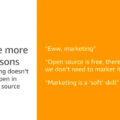Someone anonymous claiming to be an Apple employee launched a blog (now vanished) to discuss his/her thoughts on Apple’s communications with its customers. This was big news in the blogosphere, because Apple is notoriously secretive and uncommunicative.
The only Apple product I own is an iPod (I had a Mac SE 15 years ago, my first and last Macintosh), but I have read the few entries on this new blog, and the accompanying reader comments.
Many of the commenters decry the blogger’s anonymity, saying that it proves that the blog is a fake perpetrated by Apple itself as a publicity stunt. Some blogs have recently come to light claiming to be produced by individuals who “just happen” to love a company or its products so much that they would dedicate time to blogging about it, but these blogs turned out to be funded by the companies in question (e.g., Wal-Mart). Such subterfuge cannot long remain hidden in the teeming online world: when thousands of minds attack a puzzle such as “who’s really behind this blog?”, it gets solved very quickly.
The Apple blogger him/herself points out, reasonably enough, that to be identified by the company could cause her to lose her job (most of the commenters seem to assume the “Masked Blogger” is a man, while I, for no particular reason, think she’s a woman).
The Masked Blogger’s avowed purpose is to start a conversation about what Apple could be doing to communicate better with its customers. She’s asking the right questions, and some of the answers are useful. It therefore doesn’t matter whether the blog is genuine, because Apple is reading it. Whether they read it to see how their PR experiment works out, or to try to identify their rogue employee, the conversation about conversation is taking place – and Apple, volente o nolente*, is listening.
Whether they will learn anything is another question. It surprises me that this conversation is still needed. All the “new wisdom” floating around the blogosphere about how companies should communicate with their customers (the current vogue, of course, is that they should use blogs) follows principles that I invented for myself over ten years ago, starting in CompuServe forums (yes, I am a geek antique).
You want to communicate with your customers online? It’s not rocket science.
The basic principles are:
- Be honest. This doesn’t mean that you need to spill your guts and tell every company secret, but everything you do say must be absolutely true. And, when you know there’s a problem that affects customers, say so, especially if asked point-blank. Don’t imagine that you can pretend ignorance, or hide behind spin and subterfuge – you can’t.
- Be real. Not every problem is going to get fixed quickly and not every customer is going to be happy. If you explain what steps are being taken and how soon you (reasonably) expect them to take effect, customers are surprisingly forgiving. Most will love you just for showing that you’re listening and trying to help. Sometimes you can’t fix a problem; not everything customers say they want is even possible. When I worked for Adaptec/Roxio, I frequently used the line: “Fast, cheap, or perfect – pick two.” Most customers understand that businesses cannot supply everything for nothing. If you can give a reasonable explanation for why you can’t do what they’re demanding, or can’t do it as fast as they would like, they get it. And they appreciate being spoken to like capable adults. Weasel-speak only shows contempt for your listener; no one likes that.
- Be yourself. Perhaps because I started out “talking” to people personally in forums (and never wrote marketing copy for a living), it always came naturally to write in my own voice. I was surprised at how well people responded to this, telling me: “we, as customers, like the feeling that we are dealing with a real person, not a machine producing corporate ‘happytalk’.” NB: This did not mean that they wanted to hear about my vacations or what I ate for lunch or my views on politics, nor did it mean that I could tell someone he was an idiot even when I thought so – I represented the company and, when you do that, you ALWAYS have to be polite. And careful: sarcasm usually backfires online, and even mild irony gets over-interpreted.
- Be strong. It’s a hard job, representing a company online. You’re highly visible: when the shit hits the fan, you’re the first to get spattered. Because people are accustomed to being treated badly by every other company, their default assumption is that you, too, are out to screw them, that your niceness is just a ploy, it’s all a PR stunt, etc.NB: OF COURSE it’s a PR stunt – everything that you do in the name of your company where a customer can “see” you is marketing and PR (whether you – or your company – realize it). Every employee in any company who ever has contact with a customer has a chance to make or break the company’s reputation – maybe just with that one customer, maybe with many who will hear by word of mouth about that customer’s experience. What is that if not PR?
Be prepared for suspicion and abuse. Just keep smiling, and nice them to death. Trolls get bored quickly, and they are a small minority, no matter how loud. The silent majority will respect your patience, good manners, and tolerance. In fact, if you hold out long enough, they will start leaping to defend you!
- Believe. Being nice under duress does take a psychic toll, so you’d better be doing it for a company, product, or cause that you believe in. And it’s fine to defend your belief passionately: people respond to passion, even if they don’t necessarily agree with you on its target.
Okay, I’ve told you everything you need to know. Now get out there and talk to your customers!







